Estate Jewelry: Theft, Mosquitoes, and the Slipper Acrostic Ring
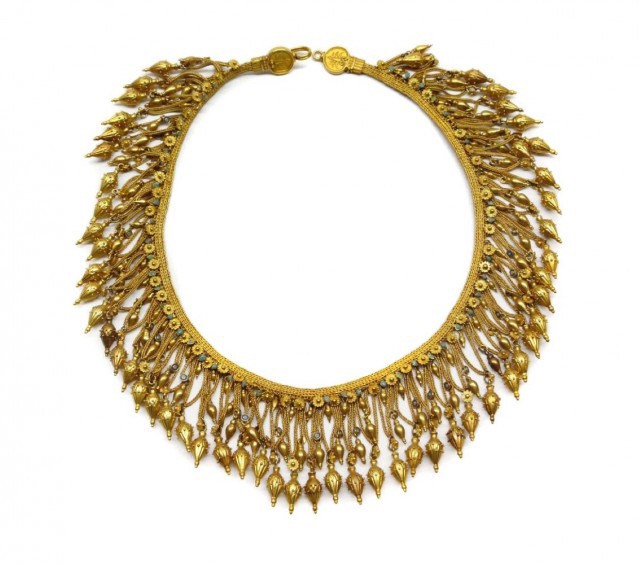
Circa 1860, this beautiful gold fringe necklace is by Castellani. Using woven chain as a support structure, it features a fringe of tiny flowers and amphorae, with little lapis- and turquoise-colored details in enamel. It was inspired by the Hellenistic “Melos” necklace (c. 330–300 BC) that now resides in the British Museum. Alessandro Castellani (who I told you about in one of my very first columns) actually restored the Melos necklace in the 1860s or 1870s, and the museum bought it from him in 1872.
The Castellani are a favorite of mine, and I was heartbroken to learn of a theft that took place at Rome’s Villa Giulia over Easter weekend. The Villa Giulia has a huge, 6,000-piece Castellani collection that includes the family’s own creations as well as ancient jewelry that they had collected and studied. The thieves used a smoke grenade to distract the guards and made a beeline for the Castellani rooms, where they grabbed an undisclosed number of the 19th-century pieces and took off. The theft got very little media coverage, and I haven’t seen a word about it since, so I don’t know if there are any leads in the case. My biggest fear is that, if the thieves cannot easily find buyers for the jewelry (which is valuable but also probably identifiable as Castellani by hallmark), they will melt it down. Heartbreaking.
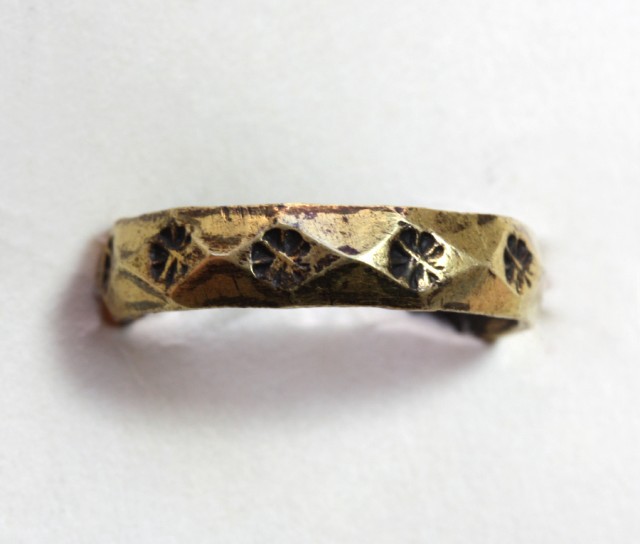
This little base metal ring dates back to the 17th century, and was found last year while excavation was being done for a new subway line beneath the Rokin, a major street in Amsterdam. It’s decorated with tiny flowers set into central diamond-shaped panels. I’m seriously tempted to buy this myself, but I’ll give you guys a head start.
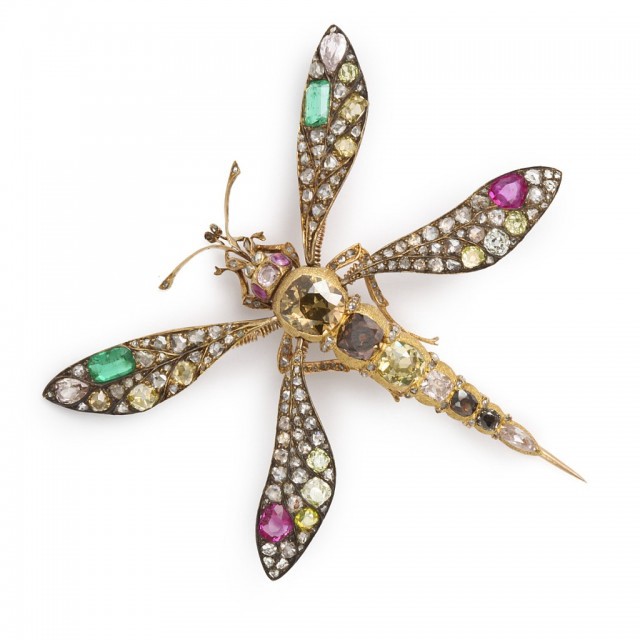
It’s not often you see a mosquito immortalized in emeralds, rubies, and 20 carats of diamonds, right? The wings of the brooch are set en tremblant, which is a French term meaning — you guessed it — “to tremble.” Tiny springs are used to connect each wing to the body of the mosquito, providing a very slight (and sometimes distractingly lifelike) movement to the piece. It’s French, circa 1880.
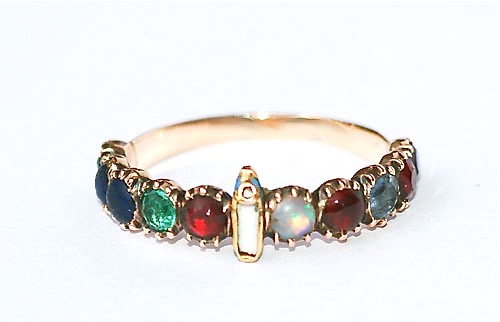
This ring, circa 1800, is already sold, but it’s just too fascinating not to mention. It’s an acrostic ring, like the ones I’ve shown you in the past that use the first letter of each gemstone to spell out a sentimental or loving word or phrase (i.e. “dearest” or “regard”). This ring, however, also nestles a tiny little enameled slipper in the center of the gemstones. Interesting!
So what does it say? Let’s look at the gemstones: From left, we have emerald, lapis lazuli, lapis lazuli, emerald, garnet, opal, garnet, sapphire, garnet and amethyst. Ellegogsga? Okay, maybe not. This is where history comes into play… The name “garnet” became popular during the Victorian era, but before that, another name for orangey-red garnet was “vermeil.” (Language being ever-evolving, “vermeil” is now pretty much universally known as a low-cost combo of silver, gold or another metal.) Also, the letters “v” and “u” were sometimes used interchangeably, so that adds another possible level of interpretation.
So with that info in mind, if we switch out all the “garnet” for “vermeil,” we now have “Elle vous va” — “it suits you” or, keeping the tiny slipper in mind, “it fits you.” The dealer (Rowan and Rowan, perpetual purveyor of amazing things) reckons that the message being sent is “this Cinderella slipper fits you, i.e. this ring is made for you, let me slip it on your finger.” Sentimental indeed.
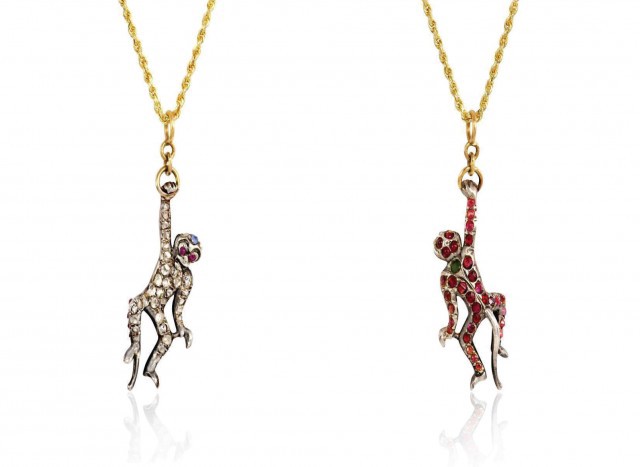
This little estate monkey charm is set with diamonds and gemstones (rubies, sapphire, and emerald?), and it doesn’t even matter if he flips over while you’re wearing him, because his back is just as cute as his front.
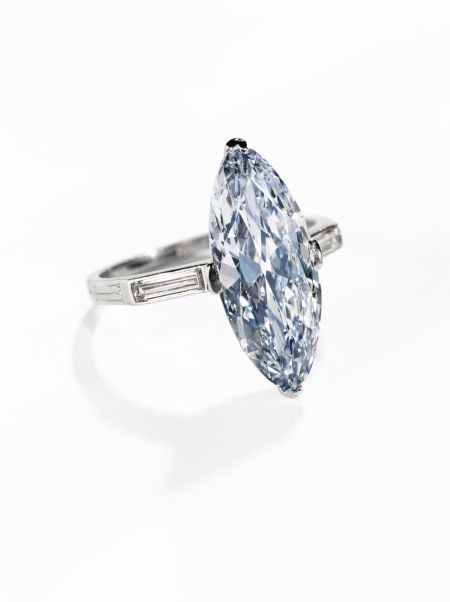
It’s auction season again, and there are a LOT of important diamonds going on the block this month. This one in particular caught my attention, because it’s big (3.50 carats), and blue, and by J. E. Caldwell, a company that pushes my sentimental buttons.
The ring will be included in Heritage Auctions’ “Jewelry Signature Auction” in New York on April 29. The diamond itself is a natural fancy blue marquise-cut, flanked by two baguette-cut diamonds in an Art Deco platinum setting.
The ring came from a New England estate, and I called Jill Burgum, Heritage’s Senior Director of Fine Jewelry, to find out a little more about it. I was particularly wondering whether the diamond could have come from South Africa’s Premier Mine (now known as the Cullinan Diamond Mine), which was — and still is — the main source of blue diamonds in the world. Jill told me that they couldn’t determine the stone’s origin, although they had tried their best to find out more about the ring. It had been owned by the same family since it was purchased in the 1920’s, and “of course we hoped they would still have the bill of sale, but you know, who keeps that?” said Jill. They also approached Caldwell’s, but again, no luck — the company has changed hands many times since it began in 1839, and the records haven’t survived. Heritage did track down an original Caldwell’s advertisement from 1927 that clearly shows the ring, though; you can see it on the auction page.
The ring is particularly exceptional because “having a blue diamond is such a rarity,” said Jill. Blue diamonds get their color from the element boron, and they are very scarce. “Most jewelers have never even seen a blue diamond — that’s how rare it is. They are truly, truly unique.”
Also adding to the appeal of this ring is a little detail that delighted both of us. Look at the underside:
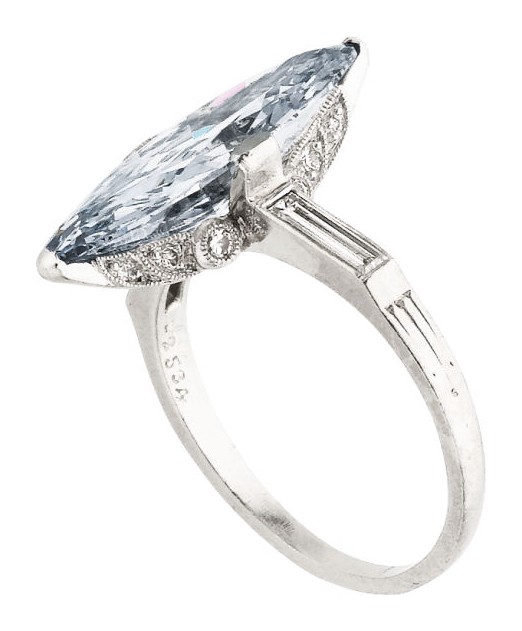
I’ve said many times in the past that I love when a piece of jewelry has a secret known only to the owner, and this setting, with the diamonds beneath the stone, is a fantastic example.
The ring is estimated at $1–1.5 million, but according to Jill, “we have room.” Especially considering this ring, which sold last spring for $2.4 million.
Philly-centric side note: J.E. Caldwell & Co was founded in 1839 by James Emmott Caldwell, a Philadelphia silversmith. Despite various changes in ownership throughout the decades, the company eventually came to be seen as the “Tiffany’s of Philadelphia,” with a particular specialty in Art Nouveau and Art Deco. This image shows what I think is the company’s first store on Chestnut Street in downtown Philly; it was built in 1868 and used until 1916, when they relocated to a new store further down on Chestnut. That 1916 store, which featured a glorious French Regency interior designed by the architect Horace Trumbauer, closed in 2003 and the original fixtures — including Baccarat chandeliers and beautiful oak cabinetry — were torn out in 2006 to accommodate a steakhouse. (I’m from Philly, and I grew up in awe of that beautiful store, so I’m trying very hard not to rage uncontrollably about this right now.) Anyway, despite a tumultuous history — I think they’ve changed hands three times in the last two decades alone — Caldwell’s is still in business, and currently has a store on Sansom Street, a.k.a. Philadelphia’s historic Jeweler’s Row.
On April 16, Christie’s will be holding jewelry auctions in New York and London. The New York “Magnificent Jewels and The Princie Diamond” sale showcases the Princie, a 34.65 carat cushion-cut fancy intense Type IIa pink diamond.
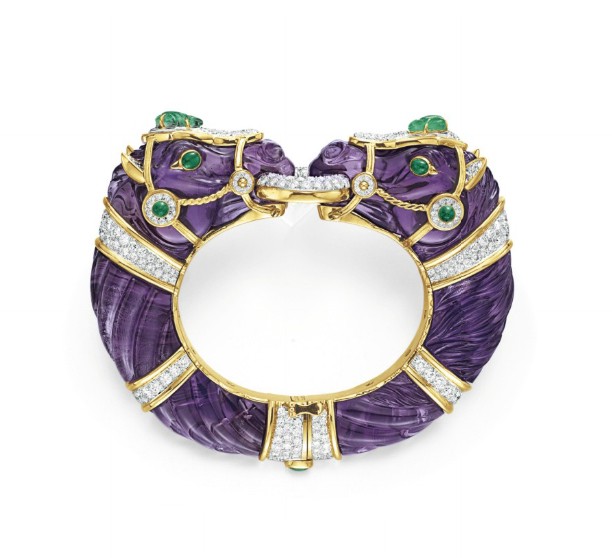
Also on auction is this gorgeous David Webb amethyst bangle bracelet. The amethyst is carved into the form of two facing horses joined by bit, with bridles of 18k gold and platinum set with cabochon emeralds and circular-cut diamonds.
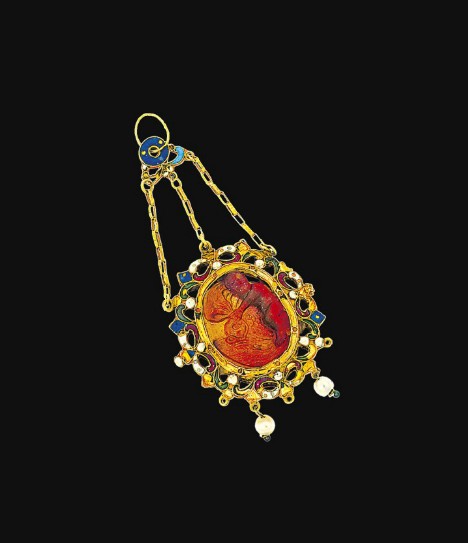
The Christie’s London auction, “Jewellery Including the Property of a Nobleman,” is a smaller sale with more eclectic lots. I confess I always prefer smaller auctions over the big “Magnificent” auctions, because I get diamond fatigue very quickly and much prefer the older, more quirky items — like this pendant, which is a great example of the style that all the 19th century Renaissance Revival jewelry was copying. Circa 1600 and possibly from Spain, it sets a central oval hessonite garnet cameo (depicting a putto — a chubby, sometimes-winged male toddler — riding a dolphin) within an elaborate openwork gold and enamel frame. The cameo hangs from another gold and enamel panel, and has a later addition of two cultured pearl drops (a third drop is missing, but who cares?).
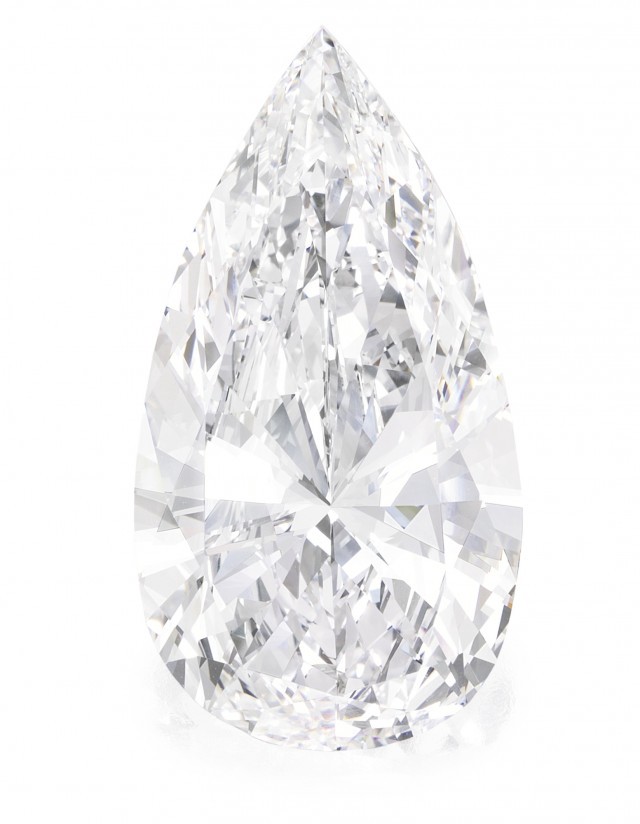
Sotheby’s New York’s “Magnificent Jewels” auction is next up on April 17. They’ve also got an exceptional diamond on offer that’s estimated to sell for $9–12 million dollars. It’s a certified Type IIa unmounted pear-shaped diamond that weighs 74.79 carats. Yeah.
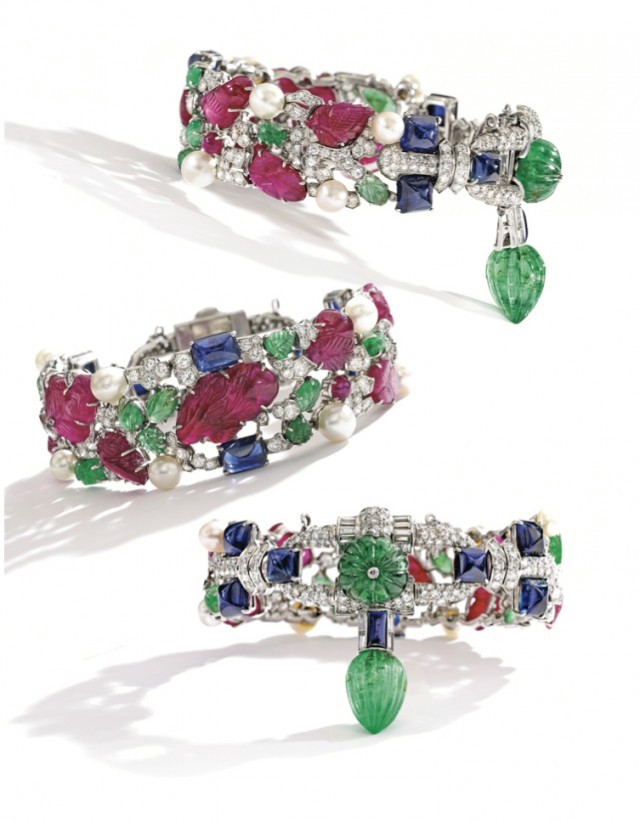
Now, I know I’ve featured a Cartier “Tutti-Frutti” bracelet in the past, but I just have to highlight this one, because it’s a feast for the eyes. Estimated at $300,000–500,000, this bracelet differs from the one I showed you previously (and from most of tutti-frutti pieces in general) because it incorporates pearls into the design. (Their inclusion is so unusual that Sotheby’s thinks they may have been a specific client request.) The eight button-shaped pearls are woven among carved rubies and emeralds, smaller cabochon rubies, sugarloaf cabochon sapphires, and approximately 7.00 carats of diamonds in various cuts. A large carved emerald drop hangs from the clasp.
The photo alone makes my mouth water — but don’t forget that Sotheby’s (as well as the other auction houses), have exhibition days in which you can actually go and TRY THESE THINGS ON. Check the auction sites for the locations and details.
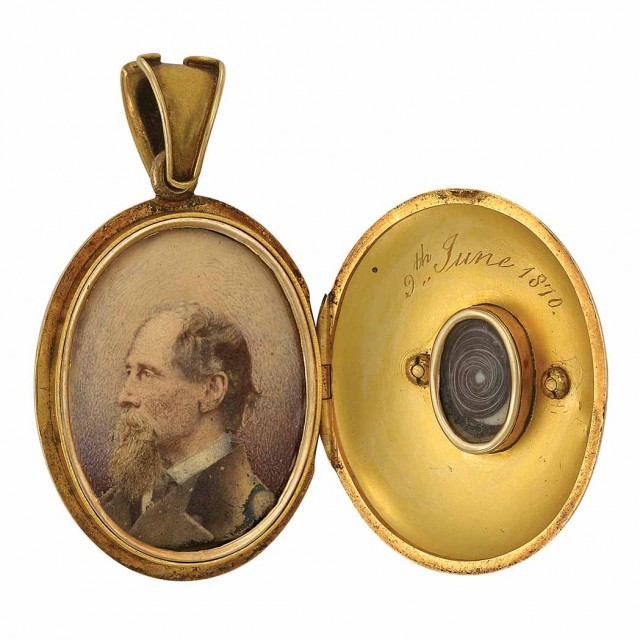
On April 23, Doyle New York will hold a “Rare Books and Autographs” auction that contains this little literary gem. A memorial to Charles Dickens, this gold locket was given to his daughter Mary (“Mamie”), and contains a lock of his hair and a small, hand-tinted portrait of the author. The locket is engraved “9th June 1870” (the date of Dickens’ death), with Charles’ initials applied to one side, and Mary’s on the reverse. It comes with a letter of provenance from Dickens’ granddaughter, Dorothy Dickens, which states, “this locket containing the portrait & hair of the late Charles Dickens, my grandfather, is absolutely genuine. It was given to his daughter Mamie from which it descended to me…” Dorothy sold the locket at auction in 1903. It has since been in the collection of professor Frederick Ives Carpenter of the University of Chicago, and, later, his descendants.
I’m not sure whether the locket was commissioned by Dickens himself before his death, or was presented by one of the family. However, while Dickens was not a fan of the trappings of mourning (he called them a “revolting absurdity” in the last few lines of his will), he is known to have given memorial lockets to family members. While rooting around the internet, I found a catalog for a 1922 Dickens-related auction in New York that lists a gold locket containing the hair of both Charles and his favorite sister Fannie. Engraved “L.A. from C.D. 1848,” he had apparently presented the locket to his other sister Letitia after Fannie’s death. Also listed among the auction lots is a locket he had given to his sister-in-law Mary Hogarth, and sadly taken back and kept after her death.
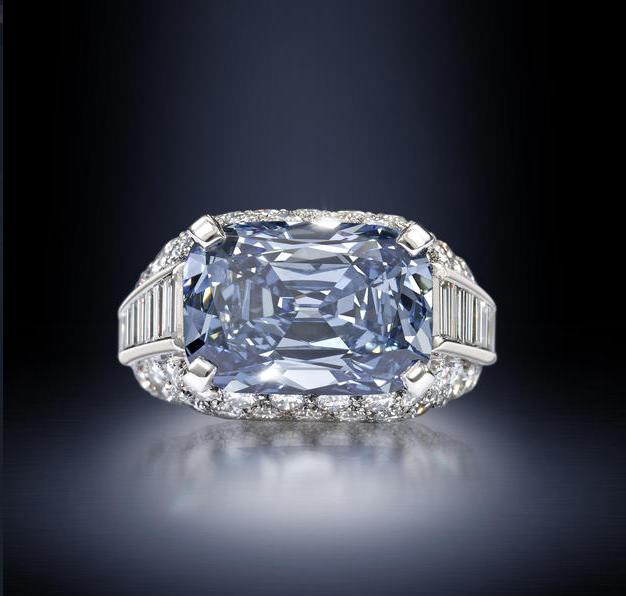
Bonhams London will hold a “Fine Jewellery” auction on April 24, and the highlight of this auction is another gorgeous blue diamond. The “Trombino” ring features a 5.30 carat fancy deep-blue cushion-cut diamond in a setting of brilliant- and baguette-cut diamonds. It’s by Bulgari, and is circa 1965.
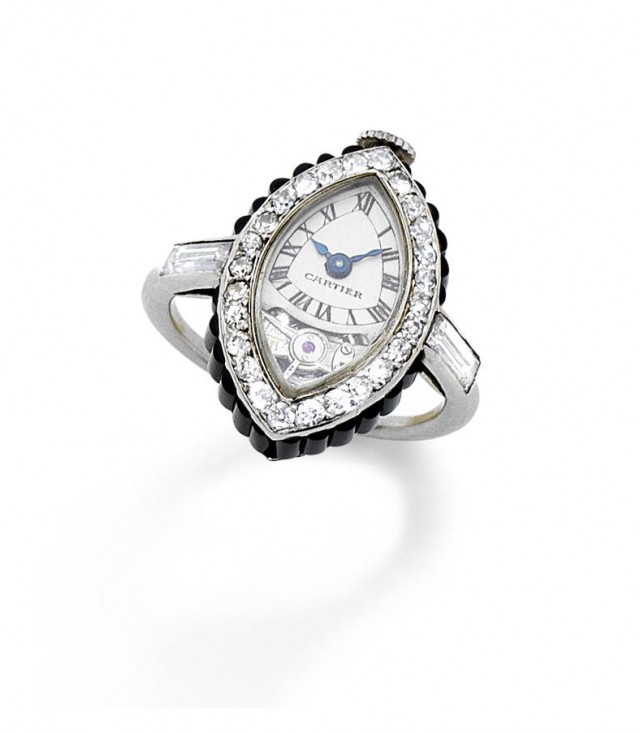
Also on offer is this neat little Cartier Art Deco ring watch. Circa 1920, the platinum “ship” case is surrounded with onyx batons topped with a crown of rose-cut diamonds. The dial features Roman numerals with blue steel hands, and is confined to the top of the piece in order to reveal the watch balance at the bottom of the face.
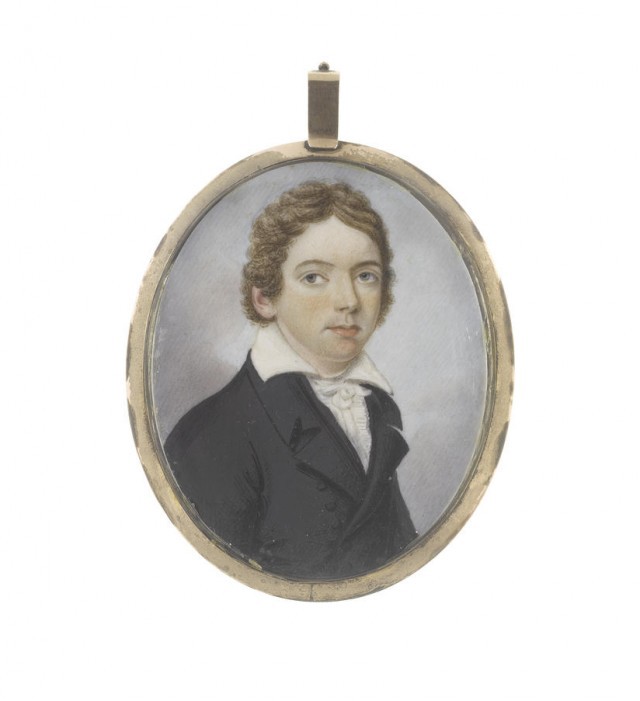
Bonhams also recently announced the sale of a rare portrait miniature of John Keats. Consigned by an American collector, the miniature depicts Keats in a straightforward pose that differs from all previous portraits of the young poet, leading the auction house to speculate that it was painted from life. The miniature is set within a gold frame and is engraved “John Keats, 1795–1821.” It will be auctioned on May 30 in the Bonhams “Fine Portrait Miniatures“ auction.
If your eyes haven’t yet fallen out, feel free to browse some other upcoming auctions including “Jewelry/Silver/Fashion” at Rago Arts on April 21, “Jewels” at Phillips New York on April 24, and “Fine Jewelry & Watches” at Freeman’s on May 6. I also recommend David Iams’ new website gavelsavvy.com for news on upcoming auctions in the Philadelphia/New York area. Iams is the former auctions editor for The Philadelphia Inquirer.
Previously: Masonic Orbs and Legendary Peacock Chokers
Monica McLaughlin can be reached at [email protected]. Feel free to contact her if you need someone to rant about Philadelphia’s crap historical preservation laws.